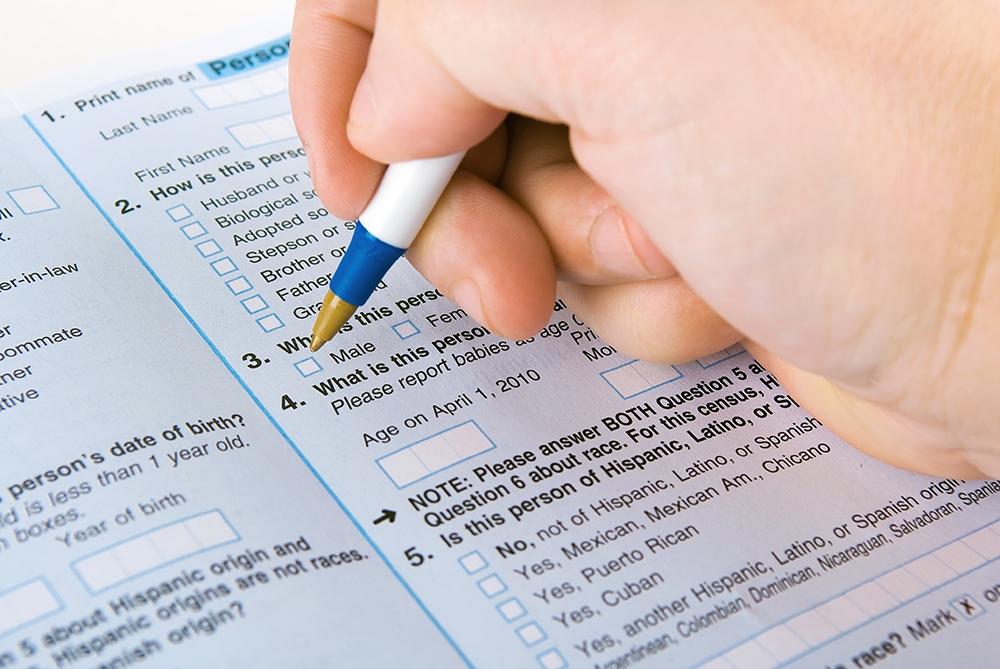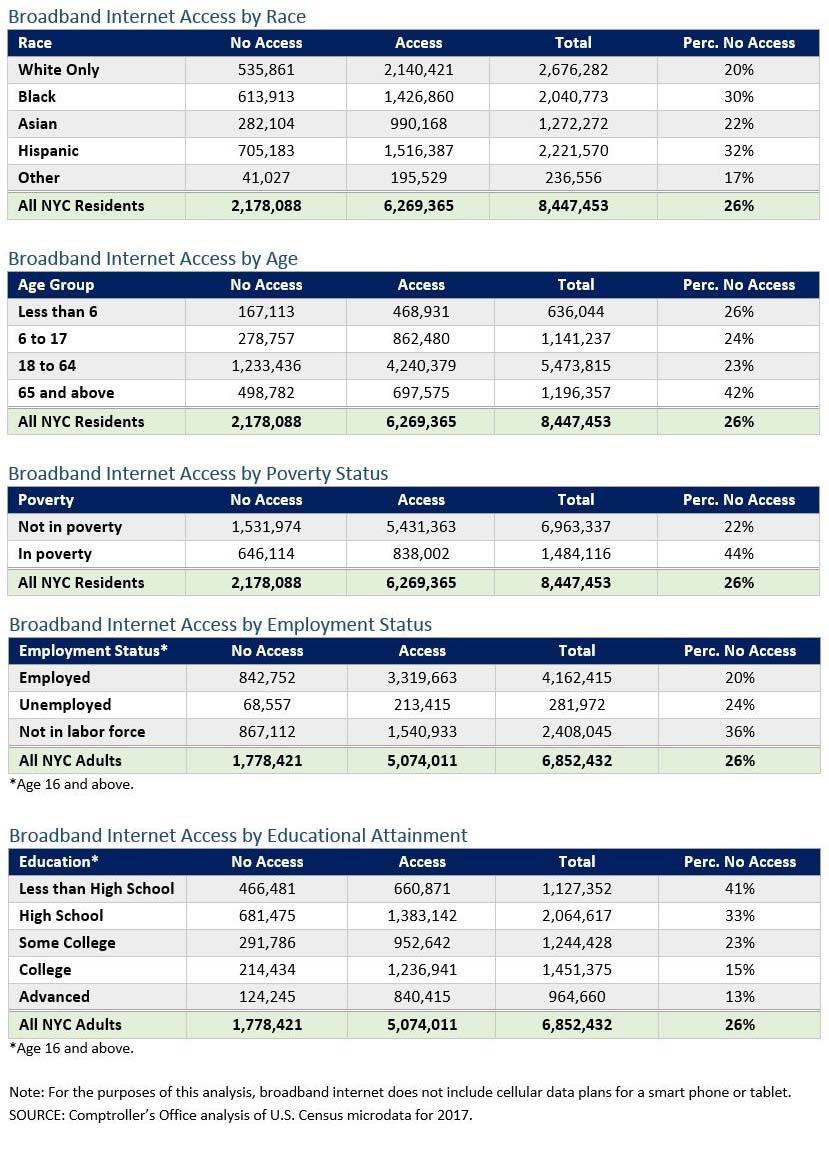Comptroller’s report finds numerous NYC neighborhoods where more than one-third of households lack internet access, rising up to 50% in others
Internet disparities most apparent in underserved communities – particularly, the Lower East Side, Hunts Point, Kensington, and Jamaica
With billions in federal aid at stake, New York City’s digital divide threatens undercount of vulnerable populations in first-ever digital Census
Comptroller urges comprehensive outreach to support Census count and demands Census Bureau provide paper forms to NYC communities at risk of undercount

New York City Comptroller Scott M. Stringer today released an alarming new report, “Census and the City: Overcoming NYC’s Digital Divide in the 2020 Census,” which spotlights how lack of internet access in low-income areas in New York City risks amplifying the Administration’s goal to corrupt an accurate count. In addition to the President’s explicit objective of scaring immigrants into the shadows through the citizenship question, which has now been blocked in Federal court, the Administration’s underfunding of the Census Bureau and lack of investment in outreach and Census testing only serve to heighten the potential harm caused by lack of internet access on the Census count. The Comptroller’s report warns that without concrete steps to fill the digital gap, New Yorkers stand at risk of being undercounted, which will only exacerbate the impact of the President’s efforts to undermine the Census. At stake for New York City is close to $6 billion in annual federal aid tied to the Census that flows into the City’s Budget, impacting everything from school lunches, to winter heating assistance for low income New Yorkers and early childhood education funding.
“When it comes to the Census, the Trump Administration has pursued an all-out assault on non-white communities in a paper-thin effort to intimidate immigrants into invisibility. They’ve failed but we can’t allow the digital divide to contribute to the President’s heinous efforts to undercount communities of color and compromise the Census,” said New York City Comptroller Scott M. Stringer. “A complete and accurate count is essential for New Yorkers to receive the resources they need – for many residents, programs that are lifelines are in jeopardy. Data is power, which is why duplicitous forces are intently focused on using the count to hold back marginalized communities. We have to do everything in our power to ensure they fail. The Census comes once every ten years – and we get one chance to get it right. Let’s ensure digital access doesn’t end up being an obstacle to a full Census count.”
The most critical determinant of successfully completing a digital 2020 Census survey is access to high-speed broadband internet at home. Households who do not receive a paper form and do not have easy access to broadband internet will be forced to fill out the 2020 Census using a mobile device, a public internet-connected computer, or dial-up internet – and are less likely to fill out the form at all. Broadband internet includes cable, fiber optic, or DSL service and usually involves a modem which provides a wired connection or wireless signal.
Comptroller Stringer’s report shows that even in 2019, internet access is not equally shared across New York City communities. If the upcoming Census effort and transition to a digital Census fail to dedicate appropriate resources to reaching those without an internet connection, vast pockets of New Yorkers could go uncounted.
The Digital Divide Threatens an Accurate Census Count
- The Comptroller’s analysis found that internet disparities are pervasive throughout New York City. Across the five boroughs, 29 percent of households – 917,239 in total – lack broadband internet access.
- In many communities, more than one-third of households do not have internet access, among them Chinatown & Lower East Side (50 percent without broadband internet access), Hunts Point, Longwood & Melrose (48 percent), Borough Park, Kensington & Ocean Parkway (46 percent), Morris Heights, Fordham South & Mount Hope (44 percent), Belmont, Crotona Park East & East Tremont (43 percent), and Jamaica, Hollis & St. Albans (43 percent).
- 17 city neighborhoods (out of 55) have a higher than average share of households without broadband internet access and recorded a lower than average response rate to the 2010 Census.
- Among households lacking broadband internet access, roughly 352,000 households pay for a cellular data plan for a smartphone or other mobile device. While these households will be able to complete the 2020 Census on their mobile device, past research on mobile Census surveys suggests that they will likely experience more difficulties in successfully completing the survey. In part due to longer loading times and more scrolling, mobile device respondents to previous Census surveys have experienced longer completion times and higher rates of starting but not completing the survey.
Marginalized Communities Most Impacted
- The Comptroller’s report also found that Internet disparities track closely to socioeconomic factors like poverty and are most apparent in traditionally marginalized communities. 44 percent of New Yorkers in poverty lack broadband internet access, as opposed to 22 percent above the poverty line.
- 36 percent of New Yorkers outside of the labor force lack a broadband internet connection, versus 20 percent for employed New Yorkers.
- About 30 percent of Hispanic and Black New Yorkers, respectively, lack broadband internet access, compared to 20 percent of White New Yorkers and 22 percent of Asian residents.
- Seniors are much more likely to be without a broadband internet connection compared to the general population. Forty two percent of New Yorkers 65 and above lacked broadband internet access, compared to 23 percent of 18 to 24 year olds.
- New Yorkers with lower educational attainment are much more likely to lack broadband internet access. Forty one percent of New Yorkers without a high school degree lack a broadband internet connection, compared to only 15 percent of New Yorkers with college degrees.

To address these glaring disparities in internet access and prevent the potentially harmful impact on Census response rates, Comptroller Stringer urged a comprehensive effort at every level of government and demanded that the Census Bureau use this information to prioritize distribution of paper forms to communities at risk of undercount. Comptroller Stringer’s recommendations include:
- Send paper forms to communities with low rates of broadband internet connectivity.The Census Bureau has committed to providing paper forms to approximately 20 percent of the nation’s population, although federal officials have yet to specify where those forms will be distributed. New York City communities with low rates of broadband internet access should be prioritized for the distribution of paper forms.
- Ensure that community based organizations, libraries, and other groups are adequately resourced for the unique challenges of a digital Census. Any organization tasked with supporting the digital Census must be given resources to adequately provide for the infrastructure and process, as well as the digital safety and security of respondents.
- Expand digital resources at public libraries. New York’s library systems play an absolutely vital role in connecting New Yorkers to the internet and are uniquely suited to help New Yorkers successfully complete the Census. The City should meet its residents where they are and give libraries the resources they need to help residents complete their Census forms.
- Expand public awareness campaigns. The transition to a digital Census elevates the importance of educating New Yorkers about the Census. Residents should be aware of all options available for completing the questionnaire and should know how to protect their personal data and how to avoid potential scams.
- Leverage city assets. In addition to leveraging public libraries, the City should utilize other trusted organizations to educate New Yorkers and facilitate survey completion, including senior centers and public schools.
- Install Census kiosks. New York City should install interactive kiosks for the public to fill out the survey in trusted locations across the city, such as places of worship, health clinics, and schools.
- Enlist Census workers with appropriate translation abilities and cultural competencies, regardless of citizenship status. To help conduct the Census, the Census Bureau will recruit hundreds of thousands of workers to act as enumerators or translators. In order to appropriately recruit a diverse range of translators, Census Bureau hiring must be granted an exemption from federal regulations that require Census employees to have U.S. citizenship.
- Prepare for problems. New York City and its community partners must be prepared for challenges and provide guidance to community outreach groups on how to respond to different situations, including problems with basic system functionality, spotty internet connections, cyberattacks, and phishing schemes.
To read Comptroller Stringer’s report, click here.